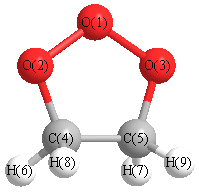Vibrational Frequencies calculated at QCISD/6-31G
| Mode Number |
Symmetry |
Frequency
(cm-1) |
Scaled Frequency
(cm-1) |
IR Intensities
(km mol-1) |
Raman Act
(Å4/u) |
Dep P |
Dep U |
|---|
| 1 |
A' |
3142 |
3027 |
28.25 |
|
|
|
| 2 |
A' |
3070 |
2958 |
20.84 |
|
|
|
| 3 |
A' |
1554 |
1497 |
0.28 |
|
|
|
| 4 |
A' |
1346 |
1297 |
0.03 |
|
|
|
| 5 |
A' |
1211 |
1167 |
1.12 |
|
|
|
| 6 |
A' |
969 |
934 |
2.34 |
|
|
|
| 7 |
A' |
875 |
844 |
0.39 |
|
|
|
| 8 |
A' |
863 |
832 |
19.92 |
|
|
|
| 9 |
A' |
749 |
722 |
1.14 |
|
|
|
| 10 |
A' |
616 |
593 |
1.35 |
|
|
|
| 11 |
A' |
345 |
332 |
5.07 |
|
|
|
| 12 |
A" |
3122 |
3008 |
0.21 |
|
|
|
| 13 |
A" |
3060 |
2949 |
19.76 |
|
|
|
| 14 |
A" |
1541 |
1485 |
0.63 |
|
|
|
| 15 |
A" |
1357 |
1308 |
9.86 |
|
|
|
| 16 |
A" |
1243 |
1198 |
0.58 |
|
|
|
| 17 |
A" |
1125 |
1084 |
0.11 |
|
|
|
| 18 |
A" |
924 |
890 |
6.86 |
|
|
|
| 19 |
A" |
687 |
662 |
16.41 |
|
|
|
| 20 |
A" |
615 |
593 |
7.37 |
|
|
|
| 21 |
A" |
52 |
50 |
3.69 |
|
|
|
Unscaled Zero Point Vibrational Energy (zpe) 14232.8 cm
-1
Scaled (by 0.9636) Zero Point Vibrational Energy (zpe) 13714.8 cm
-1
See section
III.C.1 List or set vibrational scaling factors
to change the scale factors used here.
See section
III.C.2
Calculate a vibrational scaling factor for a given set of molecules
to determine the least squares best scaling factor.
